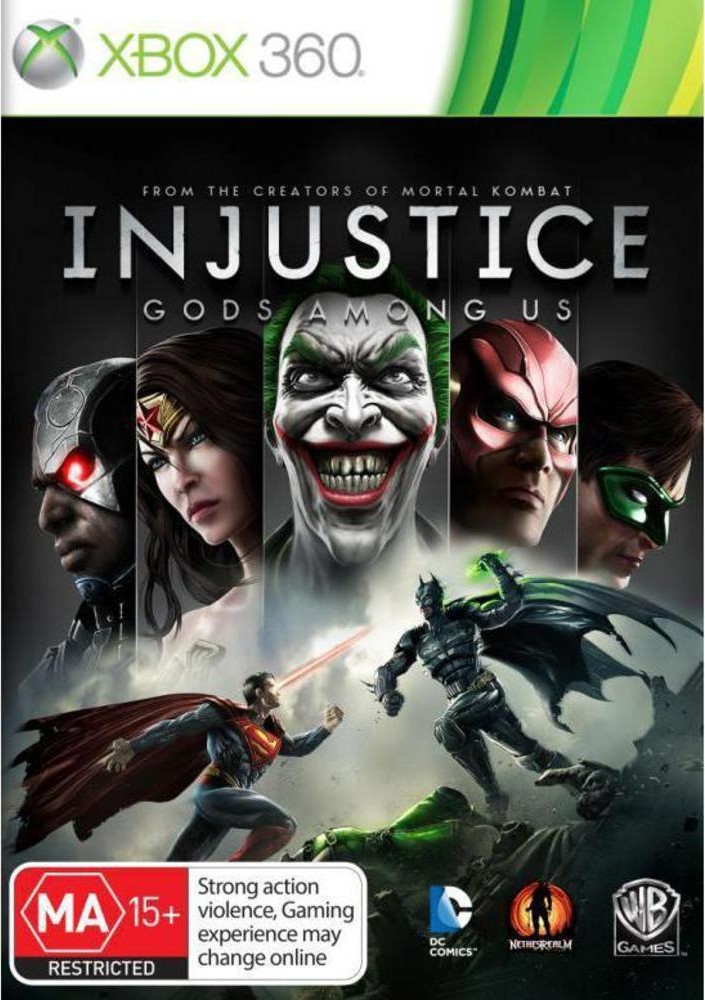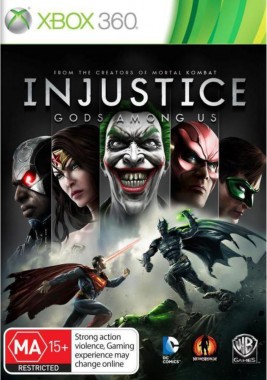
Injustice: Gods Among Us
Developer: NetherRealm Studios
Publisher: Warner Bros. Games
Format: Xbox 360 (Reviewed), PlayStation 3, Wii U
Release Date: April 17th, 2013
Price: $59.99 (Available Here)
Overview
When Warner Bros. bought the Mortal Kombat licence and team along with many other assets from the dissolving Midway Games back in 2009, it was only a matter of time before the newly renamed NetherRealm Studios would delve back into the DC Universe, this time solely under the Warner Bros. Games banner. But Injustice: Gods Among Us is no MK vs DC Universe, make no mistake about that. Have Boon and co. done justice to your favourite superheroes? Read on and find out.
Story
It’s very hard to talk about the Story Mode of Injustice: Gods Among Us without assuming a level of knowledge from the reader, because the set-up was explored in the accompanying comic series and has been touched upon in trailers, but there’s also one bit of information that is delivered shortly after starting the mode that directly addresses the fan rumours on the nature of the storyline and how, for instance, it’s possible that Hal Jordan comes face to face with a Yellow Corp version of himself. And as promised by the developers, how these heroes are able to avoid being outmatched is also explained…but I won’t go into those details.
All I can write about is the opening and the conflict between the Regime and the Insurgency, but there’s more to this than meets the eye (no, it’s not a Transformers crossover, although that would be intriguing). Metropolis is destroyed…millions dead. Batman has The Joker in custody, in the middle of an interrogation. The Joker had orchestrated a trap where Superman would fall subject to a toxic gas that caused him to hallucinate and envision Lois Lane as Doomsday. The Joker had attached a heart monitor to Lois Lane, so when she dies, a nuke would detonate in the heart of Metropolis. After all of this goes down, Superman wastes little time in busting through the wall to take matters into his own hands, interrupting the interrogation, snapping, and killing The Joker…
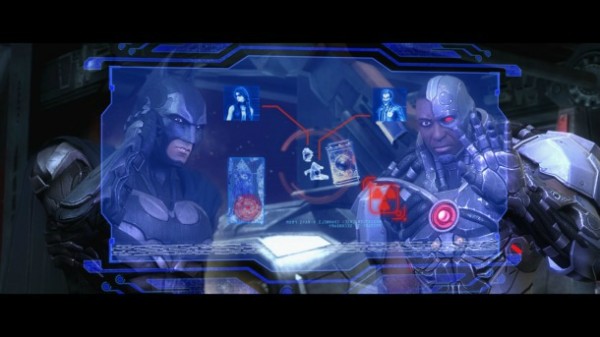
Then, we transition “Elsewhere”…I wish I could tell you what is going on “elsewhere”, but I don’t want to ruin even an early spoiler as the mode is only 4-5 hours long (finished it in just over 4 hours on normal difficulty). That was my only true disappointment by the way, but only because the Mortal Kombat story mode was significantly meatier. Then again, it was tight and effective and said what it wanted to. But, back on point… that single event molded the reality where Superman names himself High Councillor and begins the Regime, effectively turning into a ruthless dictator. This doesn’t happen overnight, as we skip forward 5 years in time. Wonder Woman, as seen, is his right-hand…woman.
Naturally, Batman is the purveyor of justice and sees the flaws in Superman’s new, controlling nature. And so a classic showdown between the Bat and Kal-El becomes inevitable with the Dark Knight’s troop of resistant heroes deemed “the Insurgency”. There are 12 character-focused chapters in Story Mode. Upon reflection, I understand the decision to only explore the good guys’ perspective first-hand; you choose sides in conflict, and embodying the bad guys could potentially breed sympathy for the dark side, who, morally, we shouldn’t be sided with. But there is a large grey area in regards to the alliances and alignments of those under the Regime, so I feel that could’ve been better exploited to some degree. Nonetheless, I really enjoyed this well-written story; definitely worthy of standing beside its comic inspirations.
Gameplay
Those who expect Injustice: Gods Among Us to play exactly like Mortal Kombat are sorely mistaken. There are three attack buttons: ‘X’ is light, ‘Y’ is medium and ‘A’ is heavy. Each character also has a dedicated character power, all of which have cool-downs and can be activated by pressing ‘B’. These can range from temporary buffs, special powers (Flash’s slow-mo effect) to a change of fight styles (Nightwing, Wonder Woman) or an ability that can be worked into combos (Batman’s mechanical bats). Blocking is now achieved by pressing away on the D-Pad or left thumbstick – which is probably the most significant change for MK fans in particular – and grapples are initiated with ‘LB’.
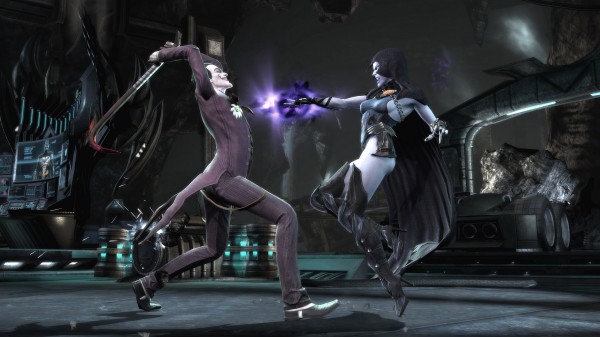
The health bar is now broken into two-tiers; once one has been depleted, the winner of that “round” does not get their health replenished like in other fighting games. So they may act as round counters for the most part, but not in that one aspect. Pulling off a “super” when your opponent has a minor amount of health left in the first tier is a waste as the move will cut off after the first blow and full damage will not be done, although you will still lose your super meter. Speaking of which, there are four bars to your super meter. This is where elements of Mortal Kombat carry through as you can “meter burn” one bar in order to enhance a special move or “block escape” (combo-breaker equivalent). Executing a block escape off a ground or wall bounce attack burns two bars instead.
Landing a wall bounce attack (away +’A’) at the borders of a level will initiate a level transition, which really increase the number of varied backgrounds in the game, each with their own interactables which can be utilised by pressing ‘RB’ once in their radius of use (‘RB’ will flash besides your health bar). The aforementioned super moves use up your entire super meter and rely on differing conditions to follow through. Lex’s, for instance, requires you to land the final hit in a string of four, even if the previous 3 are blocked. These do big damage and are entertaining to watch; they don’t pull you away from the action and rhythm of the match for too long, although fighting purists might argue that point.
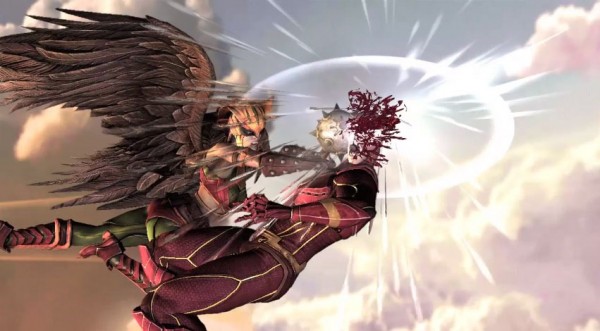
The final core gameplay mechanic is the “clash”. The clash is executed by pressing forward + ‘RT’ when getting hit and is a one-use per match feature only available to you on your second health bar (represented by a gold mini-meter underneath your health). There is a ton of strategy in the timing of its use, as the defender has the potential to gain health from a successful clash, while the attacker has the potential to do extra damage. Once initiated, a timer will begin as the two characters share a line of dialogue (covered in the audio section below). Your super meter features prominently as each bar filled is mapped to a face button. You must wager a piece, or all, of your meter by pressing the corresponding button and the difference between the values wagered determines the percentage of health returned/damage done respectively.
One thing worth noting about Story Mode is the occasional pre-fight mini-game that allows you the chance to enter the fight with your enemy at a disadvantage if successful – e.g. pressing the correct buttons to throw a series of batarangs at an advancing Lex Luthor. Outside of Story Mode, there is the Battle Mode (variations on the classic arcade ladder bookended by a motion-comic ending for the chosen fighter, which look phenomenal), S.T.A.R. Labs (reminiscent of Mortal Kombat’s challenge tower), Single Fight, Versus, Online and Practice modes. Implemented throughout is a simple XP system, whereby you unlock backgrounds, portraits and icons to customise your virtual ID – the Hero Card – and earn Access Cards and Armor Keys used to unlock a number of alternate costumes, concept art and more in the Archives, all by levelling up. More unlockables can be attained through completion of missions in the S.T.A.R. Labs. Difficulty levels range from “very easy” to “very hard”.
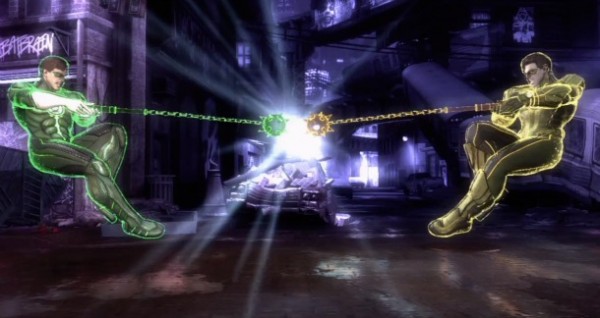
Battle Mode houses the “Classic” ladder, along with a multitude of others that give conditions for success to the player – e.g. in the Poisoned ladder, your health is being drained and so you must work to finish your opponents quickly and efficiently. These can be bought from the Archives using the aforementioned Access Cards. S.T.A.R. Labs involves completing 10 challenges per character for a total of 240, each with extra conditions as part of a 3 star scoring system ala Angry Birds; a special bonus is given for acquiring all 720 stars. I haven’t done so yet, but from what I’ve read, the prize is akin to the Mortal Kombat one…which is disappointing to say the least. These are pretty much self-contained mini-games, full of Easter-egg level inclusions.
Single Fight is self-explanatory. As is Versus; you can, however, vote on which arena to start in with a coin-flip mechanic in place for when both parties disagree, which is a neat and fair feature. Online features the usual Ranked, Player and Private match-matching capabilities as well as the ability to create and join rooms. Very few people were online when I attempted to play online, but I did manage to get in some matches…and get slaughtered in the process. There was no noticeable lag whatsoever though. There are three types of fights to engage in here: 1v1, Koth (King of the Hill, where up to 8 people observe a match, waiting their turn) and Survivor. Practice Mode is extremely deep in relation to the settings available, and allows two human players to enter.
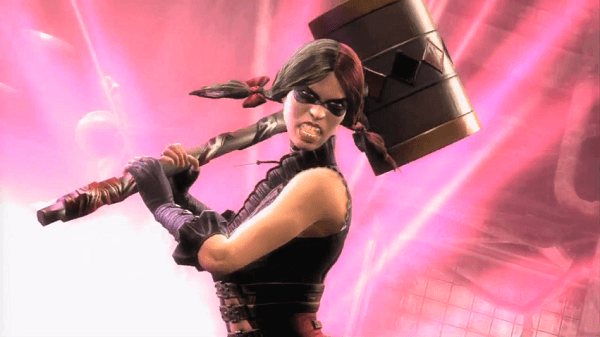
NetherRealm worked extremely hard to cater to all kinds of players as, leading on from the practice mode’s depth, you can see the frame data for each move and even tag anything from your move’s list to appear on the top-left of your screen during a fight (except in Story Mode). There’s also a quick-reference for the majority of your special moves on the main pause menu screen. All in all, they packed a tonne of features in and as well adopted as Mortal Kombat was in fighting circuits like EVO, Injustice: Gods Among Us will blow it away. And the fact that every character literally plays differently – speed and style-wise – there is so much potential for character specialisation and everyone to find their niche. And do me a favour: pick Solomon Grundy and see how weighty he is – the effect of scale in a fighting game has finally been perfected with Injustice: Gods Among Us.
Visual
Tackling the task of re-imagining such well-established characters from an institution such as DC Comics is a mammoth one. Surely, there are some who are not particularly fans of the character designs found in Injustice: Gods Among Us, with the term “too busy” being thrown around by those detractors. I happen to like theses more aggressive, battle-hardened, war-ready costumes. I think they fit the tone and atmosphere of the game and its story perfectly. It’s enlightening to actually look through the concept art for each character (which is locked initially) and see the design process – as well as some of the cutting room floor designs.
The graphical quality is great throughout, although the character models and environments in Story Mode came off as somehow less detailed. I believe it to be caused by inconsistency with the lighting engine, as even though the transition between cut-scene and gameplay is smooth, actual fights are lit much better…and it only makes sense as that is the base of the game and each scene would have to be individually lit. Story Mode is an added bonus that most other fighters plainly don’t even attempt either. Regardless, the game never looks bad; just better “in-action”. Although the choreography and blocking of the cut-scenes are well-crafted and planned out also.
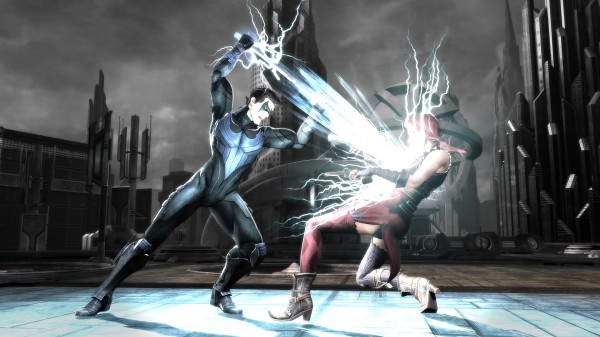
Aside from being able to view each skin and character model in the Extras sub-menu, where you can zoom-in and rotate around them in order to catch every little detail in their armour, you can also similarly view every arena in-game. Already unlocked from the start, you can go into the Extras sub-menu and observe each arena with linear camera control and the ability to systematically damage the surroundings with the press of a button. It’s very cool to incrementally destroy these beautiful made levels and notice all the details in the environmental damage and how that changes the aesthetic of the level. They can also be reset. The stages are almost treated like characters themselves in this game!
Audio
The main theme of Injustice: Gods Among Us is stuck in my head, on a loop, and will possibly stay so for the next few weeks. I did let the credits roll in-game (during which “Angel” by Depeche Mode plays), but somehow missed the sound department, did a search to see exactly who the composers were on the game. Being an MK fan, I assumed Dan Forden would be working on it, but I was surprised to find Cris Velasco & Sascha Dikiciyan (Mass Effect 2 DLC & 3) had also contributed. And that catchy main theme? Composed by Christopher Drake – who also scored the 2012 animated films Justice League: Doom and Batman: The Dark Knight Returns.
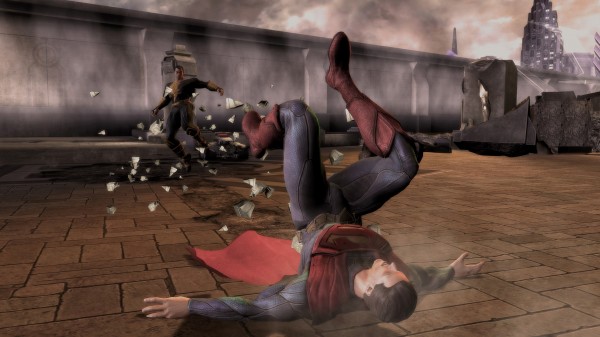
I immediately recognised the darker, signature Mortal Kombat sound in Forden’s tracks, although that’s not to say they don’t fit – quite the contrary. I loved the music all around. The sound effects are equally effective. Many may have noticed in promotional videos the unique lines of dialogue heard at the outset of a Clash, such as Superman saying to Aquaman: “You lose Arthur”. These are downright awesome. Playing a mirror match of ‘Wonder Women’ results in one saying “You can’t win, my sister” (relevant to the story in many ways).
There are also unique (scripted) lines spoken in story mode, before and after fights. One hilarious line had the smart-alleck Green Arrow making fun of Solomon Grundy’s speech after he states “Puny arrows no hurt Grundy!” with “Puny arrows yes hurt Grundy!” in a mocking tone. The script on a whole in Story Mode is full of geeky call-backs, as you get to see these mega-fights between these Gods among men with the dynamic of their relationship from the history of the comics being referenced. Voice acting overall was great, especially as numerous talents reprised their respective roles from other mediums, i.e. Phil Lamarr as Aquaman (Young Justice). And Richard Epcar is amazing as The Joker…I think Mark Hamill has his successor!
Overall
This is why I love NetherRealm Studios: content and commitment to fan feedback. As a primarily single-player, racing games and fighting games tend to lose my interest quicker than other titles. There are a few distinct factors as to why; lack of story and lack of diverse content. Ed Boon and his team make sure that this is never an issue. With its classic (albeit relatively short) comic book Story Mode, plethora of varied Battle Mode fight ladders, the fun and entertaining S.T.A.R. labs challenges and host of unlockables, it’ll be extremely hard for anyone not to appreciate Injustice: Gods Among Us. It has a low floor and high ceiling and is therefore accessible for noobs and pros alike. Fight/Mortal Kombat/DC Comics fans must buy Injustice: Gods Among Us.

Capsule Computers review guidelines can be found here.


